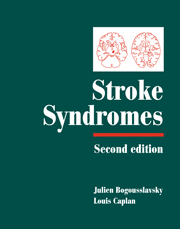Book contents
- Frontmatter
- Contents
- List of contributors
- Preface
- PART I CLINICAL MANIFESTATIONS
- 1 Stroke onset and courses
- 2 Clinical types of transient ischemic attacks
- 3 Hemiparesis and other types of motor weakness
- 4 Sensory abnormality
- 5 Cerebellar ataxia
- 6 Headache: stroke symptoms and signs
- 7 Eye movement abnormalities
- 8 Cerebral visual dysfunction
- 9 Visual symptoms (eye)
- 10 Vestibular syndromes and vertigo
- 11 Auditory disorders in stroke
- 12 Abnormal movements
- 13 Seizures and stroke
- 14 Disturbances of consciousness and sleep–wake functions
- 15 Aphasia and stroke
- 16 Agitation and delirium
- 17 Frontal lobe stroke syndromes
- 18 Memory loss
- 19 Neurobehavioural aspects of deep hemisphere stroke
- 20 Right hemisphere syndromes
- 21 Poststroke dementia
- 22 Disorders of mood behaviour
- 23 Agnosias, apraxias and callosal disconnection syndromes
- 24 Muscle, peripheral nerve and autonomic changes
- 25 Dysarthria
- 26 Dysphagia and aspiration syndromes
- 27 Respiratory dysfunction
- 28 Clinical aspects and correlates of stroke recovery
- PART II VASCULAR TOPOGRAPHIC SYNDROMES
- Index
- Plate section
2 - Clinical types of transient ischemic attacks
from PART I - CLINICAL MANIFESTATIONS
Published online by Cambridge University Press: 17 May 2010
- Frontmatter
- Contents
- List of contributors
- Preface
- PART I CLINICAL MANIFESTATIONS
- 1 Stroke onset and courses
- 2 Clinical types of transient ischemic attacks
- 3 Hemiparesis and other types of motor weakness
- 4 Sensory abnormality
- 5 Cerebellar ataxia
- 6 Headache: stroke symptoms and signs
- 7 Eye movement abnormalities
- 8 Cerebral visual dysfunction
- 9 Visual symptoms (eye)
- 10 Vestibular syndromes and vertigo
- 11 Auditory disorders in stroke
- 12 Abnormal movements
- 13 Seizures and stroke
- 14 Disturbances of consciousness and sleep–wake functions
- 15 Aphasia and stroke
- 16 Agitation and delirium
- 17 Frontal lobe stroke syndromes
- 18 Memory loss
- 19 Neurobehavioural aspects of deep hemisphere stroke
- 20 Right hemisphere syndromes
- 21 Poststroke dementia
- 22 Disorders of mood behaviour
- 23 Agnosias, apraxias and callosal disconnection syndromes
- 24 Muscle, peripheral nerve and autonomic changes
- 25 Dysarthria
- 26 Dysphagia and aspiration syndromes
- 27 Respiratory dysfunction
- 28 Clinical aspects and correlates of stroke recovery
- PART II VASCULAR TOPOGRAPHIC SYNDROMES
- Index
- Plate section
Summary
Definition of transient ischemic attacks (TIAs)
A transient ischemic attack of the brain or eye (TIA) is a clinical syndrome characterized by an acute loss of focal brain or monocular function with symptoms lasting less than 24 hours and which is thought to be due to inadequate cerebral or ocular blood supply as a result of low blood flow (hypotension), arterial thrombosis or embolism associated with disease of the arteries, heart or blood (Hankey & Warlow, 1994).
Focal symptoms are those which allow clinico-anatomical correlation (Table 2.1), whereas non-focal symptoms are not anatomically localizing and are therefore not usually TIAs (Table 2.2). The distinction between focal and non-focal neurological symptoms has a grey area, however; sensory and motor disturbances in a pseudo-radicular pattern (such as a wrist drop or tingling in two or three fingers) probably reflect focal neurological dysfunction (Youl et al., 1991; Bassetti et al., 1993; Kim, 1996); so may cognitive changes but these can be difficult to characterize and quantify and are usually not considered as focal neurological symptoms.
The symptoms of TIAs are usually ‘negative’ in quality, representing a loss of function (e.g. loss of sensation, power, vision, etc.).
If different parts of the body (e.g. face, upper limb and lower limb) are affected, the symptoms usually start at the same time and do not intensify, spread or ‘march’; i.e. they are maximal at onset.
The symptoms usually resolve slowly, but completely, within about 15 to 60 minutes (Pessin et al., 1977; Bogousslavsky et al., 1986; Levy, 1988; Werdelin & Juhler, 1988; Dennis, 1988).
- Type
- Chapter
- Information
- Stroke Syndromes , pp. 8 - 21Publisher: Cambridge University PressPrint publication year: 2001
- 1
- Cited by



